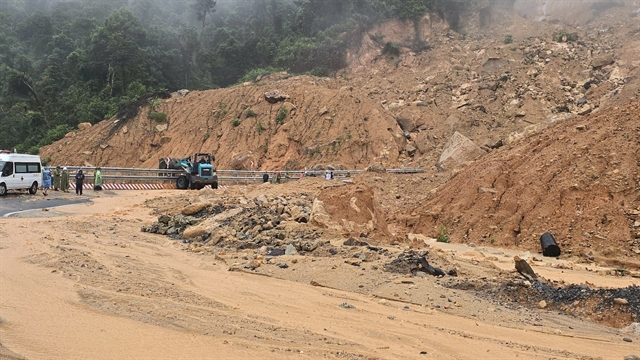 Environment
Environment

Residents in Tân Lập Commune in the northern mountainous province of Sơn La’s Mộc Châu District said while growing and processing arrowroot helped improve the lives of local residents, the rudimentary ways of processing have been killing local water sources.
 |
| Waste water discharging from an arrowroot processing household caused pollution in Tân Lập Communeof the province of Sơn La’s Mộc Châu District. — Photo baosonla.vn |
SƠN LA — Residents in Tân Lập Commune in the northern mountainous province of Sơn La’s Mộc Châu District said while growing and processing arrowroot helped improve the lives of local residents, the rudimentary ways of processing have been killing local water sources.
They said the water smelt foul and contained starch residue, probably from three arrowroot processing facilities upstream.
According to Đặng Văn Xu, a resident from Tân Lập Commune’s Co Phay Village, local residents earlier used to bathe in the Áng Stream and wash their clothes there but not anymore since the water has now turned black and emits a bad smell.
Ever since the facilities became operational, fish, shrimp and crabs in the stream have gradually disappeared.
"The smell becomes terrible when it rains," he said.
Lò Văn Xinh, head of Tân Lập Commune’s Nà Pháy Village, said local residents repeatedly sent complaints about environmental pollution in the area and district authorities did dispatch working groups to look into the issue but the situation had not yet improved.
Lèo Văn Pâng, deputy chairman of Tân Lập Commune, said now an area of 400ha was under arrowroot cultivation, producing nearly 12,000 tonnes of yield per year.
The commune has three arrowroot powder processing facilities which have been polluting the environment ever since they began production in 2008.
Although these facilities made a commitment that waste water would be treated before it flowed into the canals, they did not keep their word.
Arrowroot residue and untreated waste water stays in ditches dug by local households near the processing workshops. When it rains, the waste water from the ditches near the stream overflows into the water facility.
Pâng said local authorities had proposed to the district’s leaders to put in place measures to tackle pollution in the area but even after so many years, the problem persists.
Delivering a warning and asking the facilities to pay an administrative fine of less than VNĐ2 million (US$90) were all that the local authorities could do within their power, he said.
Pâng said in 2014, the environmental police had imposed over VNĐ20 million (US$897) fine on each facility but that did not prevent them from discharging untreated waste water into the environment.
Hà Văn Nhảy, a local official, said generally, between 5 and 6 cu.m of water was needed to process one tonne of arrowroot and the same amount of waste water is discharged together with 600-700 kg of residue.
He estimated that the three facilities could be releasing between 500-600 cu.m of waste with 60-70 tonnes of residue every day.
The contaminated water is not only affecting residents of Tân Lập Commune but also more than 250 other households who live along the stream.
According to Mộc Châu District’s People’ Committee, there are ten arrowroot processing workshops in the district.
Hà Trung Chiến, chairman of the district’s People’s Committee said authorities understand the problem and regularly conducted inspection visits to the workshops. However, he said, the state regulations to punish violators were not strict enough to stop water pollution.
Whenever inspection teams came, the facilities stopped their operations, resuming their activities soon after that, he added.
Chiến said in the future, the local authorities would request the facilities to implement their commitment on environmental protection. Also, they would supervise the facilities better.
The district authorities would also take additional measures like imposing administrative fines and seizing production equipment if they continued their activities. — VNS




